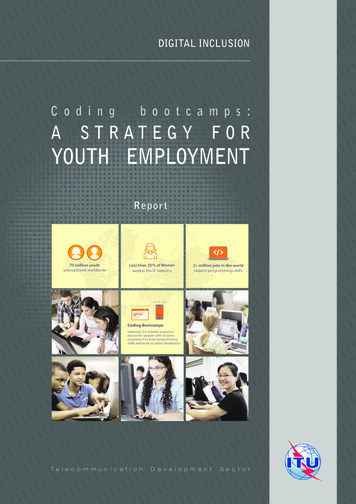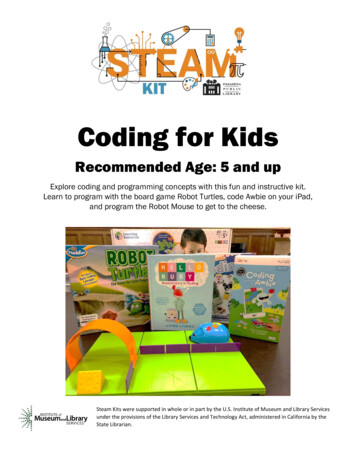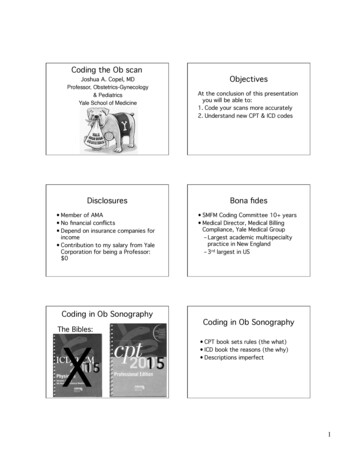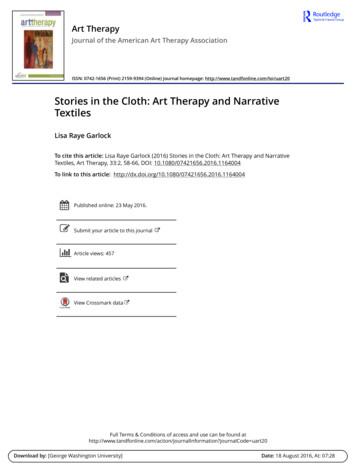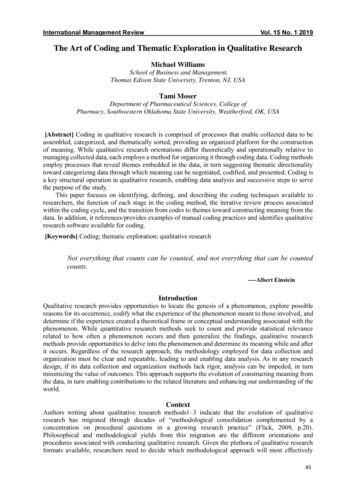
Transcription
International Management ReviewVol. 15 No. 1 2019The Art of Coding and Thematic Exploration in Qualitative ResearchMichael WilliamsSchool of Business and Management,Thomas Edison State University, Trenton, NJ, USATami MoserDepartment of Pharmaceutical Sciences, College ofPharmacy, Southwestern Oklahoma State University, Weatherford, OK, USA[Abstract] Coding in qualitative research is comprised of processes that enable collected data to beassembled, categorized, and thematically sorted, providing an organized platform for the constructionof meaning. While qualitative research orientations differ theoretically and operationally relative tomanaging collected data, each employs a method for organizing it through coding data. Coding methodsemploy processes that reveal themes embedded in the data, in turn suggesting thematic directionalitytoward categorizing data through which meaning can be negotiated, codified, and presented. Coding isa key structural operation in qualitative research, enabling data analysis and successive steps to servethe purpose of the study.This paper focuses on identifying, defining, and describing the coding techniques available toresearchers, the function of each stage in the coding method, the iterative review process associatedwithin the coding cycle, and the transition from codes to themes toward constructing meaning from thedata. In addition, it references/provides examples of manual coding practices and identifies qualitativeresearch software available for coding.[Keywords] Coding; thematic exploration; qualitative researchNot everything that counts can be counted, and not everything that can be countedcounts.----Albert EinsteinIntroductionQualitative research provides opportunities to locate the genesis of a phenomenon, explore possiblereasons for its occurrence, codify what the experience of the phenomenon meant to those involved, anddetermine if the experience created a theoretical frame or conceptual understanding associated with thephenomenon. While quantitative research methods seek to count and provide statistical relevancerelated to how often a phenomenon occurs and then generalize the findings, qualitative researchmethods provide opportunities to delve into the phenomenon and determine its meaning while and afterit occurs. Regardless of the research approach, the methodology employed for data collection andorganization must be clear and repeatable, leading to and enabling data analysis. As in any researchdesign, if its data collection and organization methods lack rigor, analysis can be impeded, in turnminimizing the value of outcomes. This approach supports the evolution of constructing meaning fromthe data, in turn enabling contributions to the related literature and enhancing our understanding of theworld.ContextAuthors writing about qualitative research methods1–3 indicate that the evolution of qualitativeresearch has migrated through decades of “methodological consolidation complemented by aconcentration on procedural questions in a growing research practice” (Flick, 2009, p.20).Philosophical and methodological yields from this migration are the different orientations andprocedures associated with conducting qualitative research. Given the plethora of qualitative researchformats available, researchers need to decide which methodological approach will most effectively45
International Management ReviewVol. 15 No. 1 2019enable their study. “Qualitative research is not based on a unified theoretical and methodologicalconcept. The variety of approaches results from different developmental lines in the history ofqualitative research, which evolved partly in parallel and partly in sequence” (Flick, 2009, p. 306).As qualitative research has evolved and methodologies for collecting and organizing data havematured, specific strategies and structures for managing data in these areas have emerged and becomecommon practice. A key data organizing structure in qualitative research is coding. “A code inqualitative inquiry is most often a word or short phrase that symbolically assigns a summative, salient,essence-capturing, and/or evocative attribute for a portion of language-based or visual data” (Saldafia2009, p.3). Initially, coding began as a progressive three-part schema; First, Second and Third levelcoding guided by the formula “from codes and categories to theory” (Saldafia 2009, p. 4). From theseearly coding strategies, additional coding strategies evolved associated with the emergent types ofqualitative research methods (e.g., Phenomenological, Grounded Theory). This paper reviews thecoding strategies associated with qualitative research using Grounded Theory method as an examplefor demonstrating the uses of the three-step coding process; open, axial, and selective coding.Brief Historical PerspectivesThe Ground Theory Method (GTM) of qualitative research emerged from the work of BarneyGlaser and Anselm Strauss, aligned with the Chicago School of symbolic interactionism, which rose toprominence in the early part of the twentieth century (Glaser, 1967). In their seminal work “Thediscovery of grounded theory: Strategies for qualitative research,” the authors suggested a pluralist andflexible approach to data coding (Strauss, 1998). “Our principal aim is to stimulate other theorists tocodify and publish their own methods for generating theory and join us in telling those who have notyet attempted to generate theory that it is not a residual chore in this age of verification’’ (Glaser, 1967.p. 8).While encouraging researchers towards a “pluralist and flexible” orientation to coding and tooriginal methods for “generating theory,” the reference to “not a residual chore in this age of verification”is significant, as it is a reference to the quantitative research as being the dominant research method ofthe time. This initial philosophic frame suggests that researchers employing qualitative researchmethods, in this case GTM, should not engage in data organizing strategies indiscriminately. Instead,they should apply guiding principles that intentionally enable them to “codify and publish their ownmethods for generating theory” (Strauss, 1998, p.189). The focus on articulating a clear methodologicalframework that is both rigorous and able to be replicated, suggests a researcher engaged in qualitativeresearch is using a viable research method. “The pluralistic nature of GTM [does not] mean thatresearchers can do pretty much whatever they want there are certain principles about which groundedtheory, proponents concur and as long as these principles are kept in mind, the details of the procedurecan be modified to suit a researcher’s needs” (Larossa, 2005, p. 840).In this context, the GTM was one of the first qualitative methods to have a systematic approach forcodifying and categorizing data in order to generate theory. As a result, researchers were provided withthe methodological means to construct meaning from research findings through a three-phase codingmethod. The coding method enabled a progressive and verifiable mechanism for establishing codes,their origins, relationships to each other, and integration resulting in themes used to construct meaning.The construction of meaning from collected data is the result of the progressive data coding process.In order for researchers to generate theory, researchers need to evidence employing an analytic approachand rationale methodological decisions. “Through explicating their decisions, grounded theorists gaincontrol over their subject matter and their next analytic or methodological move. The construction ofthe process, as well as the analytic product, is emergent theory” (Charmaz, 2008, p. 408).Open, axial and selective coding of collected data results in the creation of theory, leading theresearcher to construct deeper theoretical meaning. This method of coding provides researchers withnuanced access to study informants’ thoughts, perspectives, and reactions to study topics. Codingenables informant data to be gathered and analyzed relative to “what they do, how they do it, and whythey do it interacting in the research setting” (Charmaz, 2008, p. 408).46
International Management ReviewVol. 15 No. 1 2019CodingQualitative research generally and Grounded Theory Methods specifically is an inductive, not adeductive, approach to qualitative research. While deductive research focuses on casualty and testingtheory, inductive research focuses on generating theory from collected data. In the GTM approach, datacollection activities (e.g. interview, observation, and artifact review) requires the researcher to bepresent and be aware of the dynamic nature of the data, its thematic connectivity, intersectionality, andemergence toward theory creation. “Data collection, analysis and resultant theory generation has areciprocal relationship it requires a constant interplay between the researcher and the data” (Charmaz,2008, p. 47). Central to the coding process is ensuring that coding procedures are defined, rigorous,and consistently applied in order to conform with validity and reliability standards associated withqualitative research. Historically, this orientation of insisting on rigorous data coding procedures istraceable to seminal work in qualitative research, indicating that “joint collection, coding and analysisof data is the underlying operation [toward] the generation of theory” (Glaser, & Strauss, 1967, p. 43).Figure 1. Overview of coding process: Open, Axial and Selective CodingRecognizing the interdependent relationship among data organization, categorization, and theorydevelopment construction of meaning, coding plays a pivotal role in facilitating the researcher’s abilityto advance effectively the research process. “Coding is oriented around the central concept of [seeking]to represent the interplay of subjects’ and researcher’s perceptions of the nature and dimensions ofphenomena under study” (Douglas, 2003, p. 48).Importantly, the open, axial, and selective coding strategy enables a cyclical and evolving data loopin which the researcher interacts, is constantly comparing data and applying data reduction, andconsolidation techniques. As the coding process progresses, its dynamic function and nonlineardirectionality enables essential themes to be identified, codified, and interpreted in the service of aresearch study’s focus and contributes to the associated literature. This cyclical process is both an artand science, requiring the researcher to understand intimately the data by continuously reading andrereading the collected data in order for theory to evolve.Figure 2. Linear Process for Qualitative Research47
International Management ReviewVol. 15 No. 1 2019Figure 3. Non-Linear Process: Qualitative ResearchNote. The process evolves into a cyclical process when moving between the three coding methods.The researcher must treat these as a non-linear.Open CodingOpen coding is the first level of coding. In open coding, the researcher is identifying distinctconcepts and themes for categorization. The first level of data is organized by creating initial broadthematic domains for data assemblage. “The first step [open coding] aims at expressing data andphenomena in the form of concepts. Units of meaning classifying expressions (single words, shortsequences of words) in order to attach annotations and "concepts” (Flick, 2009, p. 307). In open coding,this process was termed the concept-indicator model. In brief, the concept-indicator model used constantcomparison of [textual] indicators and focused on comparing regularly occurring textual material. Thisapproach was accompanied by the ongoing coding of themes as an indicator of a concept, alwayscomparing it to previous indicators that had been similarly coded (Saldafia, 2009).In practice, the researcher needs to sift through informant’s responses and organize similar wordsand phrases, concept-indicators, in broad initial thematic domains. For example, “indicators are symbolsor conventional signs, thus a man and woman are concepts. So are love, mate selection, divorce, death,and depression” (Strauss, 1998. p.841).Central to the efficacy of open coding is approaching the thematic fragments and coalescingconcepts identified during data collection in an organized and systematic way. Prior to the use ofqualitative research software programs, organizing data for open coding required a multifacetedresearch skill set. For example, researchers would read and re-read interview transcriptions, field notes,and associated data sources involved in the data collection searching for thematic connectivity leadingto thematic patterns. Next, the researcher would color code aligned themes, cut the themes out(producing small paper fragments with the themes), and adhere the paper fragments on index cards inpreparation for more precise assessment and axial coding. While this approach was subject to possibleerrors in overlooking or miscoding them, this rudimentary data organizing strategy could be a relativelyeffective process enabling open coding.Today, researchers have the option of using qualitative software to enable the same process usingcomplex data analysis tools. The advent of the use of qualitative software has expanded the ways thatresearchers can work through the coding cycles. In addition, the more advanced qualitative softwarepackages provide opportunities for statistical analysis overlaying the coding process. The researcherstill must move through each phase of coding; the software simply supports an easier capture of theresearchers’ coding and construction of meaning.48
International Management ReviewVol. 15 No. 1 2019Table 1Qualitative SoftwareSoftwarePrice: EducationOperating SystemsIOS Export to SPSS No No No No WebWebNo WebWebNo Faculty: 600.00Student: 85 (24 months) Atlas.tiQDA MinerHyperResearchQuirkosDedoosewebQDAFaculty: 595.00Student: NoFaculty: 499.00Students: 199.00Faculty: 340.00Student: 69.00 10.95 per month 131.40 (12 months) 50.00 (90 days) 165.00 (12 months)Windows Faculty: 670.00Student: 99 (24 months)MixedMethodsPro ulty: 565.00MAXQDA Plus 2018 Student: 99 (24 months)Nvivo PlusStatisticsOnce the researcher determines that a theme has emerged and is recognized, it would be providedwith a code. The object is “to arrange things in a systematic order, to make something part of a systemor classification this permits data to be “segregated, grouped, regrouped and relinked in order toconsolidate meaning and explanation” (Lincoln, 1985, p.21).Determining a code for emergent themes from the data can be more art than science. For example,as themes or patterns coalesce, there may be a variety of codes that could effectively corral the themes.However, providing a code prematurely, prior to fully understanding a theme’s content anddirectionality, could hinder its evolving associations with other themes. One approach to choosing acode is employing “classification reasoning plus tacit and intuitive senses to determine which data “lookalike” and “feel alike” when grouping them together” (Lincoln, 1985, p.347). Identifying a sufficientlydeveloped theme and determining an appropriate code requires attention to thematic association and asubjective sense of a code’s accurate representation of the essence of a theme.Open coding in qualitative research presents opportunities for sub-coding data. Determining whatdata to capture and how to display it is a critical aspect of the research design. Data presentation in opencoding can be managed in numerous ways. Often, the form of presentation reflects the processes of itscollection. For example, words, phrases, or sentence fragments of different emergent themes can belisted on different pages, and field notes counting the number of times a word was repeated in aninterview could be graphed or relevant characteristics from photographs of an informant group couldbe referenced in a multi-photo archive. “The result of open coding should be a list characterizing codesand categories attached to the text and supported by code notes that were produced to explain the content49
International Management ReviewVol. 15 No. 1 2019of codes. These notes could be striking observations and thoughts that are relevant to the developmentof theory” (Flick, 2009, p. 310).Figure 4. Open Coding: Thematic material identified in reviewing collected data that could serve ascategories in axial coding.A practical approach to determining codes is using the “5W-1H” (e.g. who, what, where, when,when, and how) questions as a foundational way for exploring and examining data in order to “listcharacterizing codes and categories attached to the text” (Flick, 2009, p. 311). This approach enablesthe researcher to parse and organize thematically similar data so that unique codes can be applied. Codeselection can be used in open, axial, and selective coding in order to identify foundational thematiccontent and directionality (Flick, 2009). Operationally, there are various strategies for displaying datain open coding. Therefore, researchers can be creative and innovative in designing data open codingmechanisms that will best enable their research activities.Axial CodingAxial coding is the second level of coding. In contrast to open coding, which focuses on identifyingemergent themes, axial coding further refines, aligns, and categorizes the themes. With the completionof open coding and transition to axial coding, collected data can be sifted, refined, and categorized withthe goal of creating distinct thematic categories in preparation for selective coding. “Axial codingidentifies relationships between open codes, for the purpose of developing core codes. Major (core)codes emerge as aggregates of the most closely interrelated (or overlapping) open codes for whichsupporting evidence is strong” (Strauss, 1998, p. 109). In order to achieve this organizing objective,researchers need to engage in continuous analysis, cross referencing, and refining theme categorization.There are three refinement activities associated with axial coding that enable and advance effectivecontent categorization.First is possessing a clear understanding of the analytic methods used in refining data and category50
International Management ReviewVol. 15 No. 1 2019construction. As the researcher reviews the thematic material collected through open coding, thematerials must be examined in the context of inductive and deductive analysis. As stated earlier in thispaper, deductive reasoning tests theory by collecting and examining empirical data to determine if it istrue, while inductive reasoning seeks to construct theory from data collected and analyzed with the goalof explaining research findings. The process of analyzing data is dynamic, requiring the researcher toconsider a multivariate field of possible influencers relative to findings. Using inductive and deductiveapproaches to data analysis can maximize analytic acuity and enable precise thematic categorization.The categories that are finalized from axial coding serve as the axis point or hub in axial coding. Forexample, a wooden wheel metaphor is used to describe axial coding by locating key categories as thehub and subcategories to the spokes of the wheel (Glaser, & Strauss, 1967). Another description of axialcoding is the “Six C’s Model.” This model encourages categorization using provided key perspectivesfor further organizing and categorizing data through ‘‘causes, contexts, contingencies, consequences,covariance, and conditions’’ (Larossa, 2005, p.98). While these coding activities are associated withqualitative research, considering relevant deductive approaches to testing theory remains an importantdata comparison strategy facilitating continuous review, reconsideration, and reflection.Second is the constant comparison method. The constant comparison method is a data organizingand refining activity. While there are differing approaches to implementing the constant comparisonmethod, its focus is to compare continually data collected, emergent themes, and their coding in orderto continually create, refine, and newly create categories in preparation for selective coding. Thematiccomparison and analysis are central to axial coding, as the critical focus is on organizing themes intocogent and comprehensive categories. In axial coding, as well as the other coding types, the researchermust understand the function of the coding and associated analytic activities in order to make informedresearch designs. ‘‘Bringing process into the analysis is an important part of any grounded theory study”(Strauss, 1998, p. 163). This is an important understanding relative to the relationship between codingand analysis as analysis facilitates coding.Third is “line-by-line” coding. In line-by-line coding, each textual line of an interview or documentis scrutinized with the goal of maintaining the researcher’s focus on the text. Through this approach,the researcher can deeply engage the text, and, in turn, recognize and codify nuances and discretethematic connectivity with other themes. “Researchers do not want to impose a pre-existing frameworkonto the data, but rather to let new themes emerge from it. Through keeping ‘close to the data’continuously sifting through themes, idea fragments and seemingly unrelated utterances, data categoriescan become thematically stabilized, defined and differentiated” (Charmaz, 2014, p. 80). Remaining“close to the data” requires the researcher to immerse herself in the text, explore its nuances andsurrender biases. By progressing engaging data “line-by-line,” a rhythm or cadence of analysis occurs,assisting the researcher in being methodical and, perhaps, pedantically focused on identifying textualsubtleties fueling the construct of meaning. Through employing inductive and deductive reasoning, theconstant comparison method, and line-by-line coding, the integrated essence of the thematic materialcan be identified and categorized.51
International Management ReviewVol. 15 No. 1 2019Figure 5. Axial Codes: Creating categories from open codesIn open coding, themes are being developed: an informant’s musing, a hand-written note in themargin of a memo, or an elaborate monologue from a spontaneous utterance from an unscheduled actor.However, the interrelatedness of the thematic material remains unexplored and unanalyzed. In axialcoding, the relationships among themes are explicitly stated, examined, and categorized. “If thedevelopment of theory rests heavily though not entirely on explanation and if explanation rests on howvariables and their interrelatedness are empirically or logically established, then axial coding is thephase in which research begins to fulfill its theoretical promise” (Bengston, 2006, p.28).Selective CodingSelective coding is the third level of coding. It enables the researcher to select and integratecategories of organized data from axial coding in cohesive and meaning-filled expressions. “Selectivecoding continues the axial coding at a higher level of abstraction [through] actions that lead to anelaboration or formulation of the story of the case” (Flick, 2009, p. 310). Central to enabling the storyor case to emerge from the data categories is the process of enabling further refinement of the data,selecting the main thematic category, and then in a systematic manner aligning the main theme to othercategories that have been selectively coded. “The conceptualization of the yield from the selectivecoding as a ‘case’ or ‘story’ is significant as it provides researchers with flexible and multi-type vehiclesfor codifying and presenting study results” (Strauss, 1998, p. 158). This approach to data framingenables the researcher to work continually toward thematic specificity and, in turn, theory creation. Inselective coding, degrees of causality or predictability can emerge from the thematic refining process,allowing the researcher to identify sets of circumstances in which certain responses will elicit responsesthat suggest certain circumstances receive unique and differentiated responses. With the work ofselective coding done, the researcher can move toward developing theory and ultimately constructingmeaning.52
International Management ReviewVol. 15 No. 1 2019Figure 6. Open Codes to Selective ThemeNote: Typically, numerous thematic fragments in the collected data can be captured in open coding,enabling as if thematic materials to be integrated forming key categories using axial coding that arethen further refined to one unique theme in selective coding. Frequently, research studies yieldnumerous selective codes; enabling researchers develop theory resulting in a theoretical frameworkand the ability to construct meaning.Selective coding is a uniquely challenging phase of the data collection process of the researchdesign in that it influences not only what theoretical constructs emerge, but also how meaning is createdthrough presentation, impacting the reception of the findings. For example, if the meaning of thefindings is expressed in the form of a case of story, the presentation can vary in form and style. Authorswrite about the format when finalizing the outcome of selective coding process. “Some researchers mayprefer to tell idiographic stories, with anecdotal indicators fleshing out the particulars, while others maylean toward theoretical stories, accounts of how a complex of variables are interrelated” (Larossa, 2005,p. 201). The outcome of selective coding enables researchers to craft case stories that accurately andpowerfully present the sum of the progressive coding process. Selective coding fuels expression andfacilitates the construction of meaning.53
International Management ReviewVol. 15 No. 1 2019Figure 7. Creation of Theory and MeaningNote. The coding process outcome can be theory development and the construction of meaningassociated with the research purpose.Coding in qualitative research enables researchers to identify, organize, and build theory. The roles ofopen, axial, and selective coding are critical to achieving the research goals of a study, as they provideopportunities for researchers to immerse themselves in the data. Coding promotes thematic integrationand organizational strength, enabling researchers to be reflective and reflexive in joining the data innuanced and intimate ways and employing the outcomes from the coding process to create meaning.ConclusionCoding in qualitative research enables researchers to identify, organize, and build theory. The roles ofopen, axial, and selective coding are critical to achieving the research goals of a study, as they provideopportunities for researchers to immerse themselves in the data. Each stage of the coding processprogressively integrates the emergent themes acquired during data collection and continually refinesthe themes culminating in theory development and the creation of meaning.ReferencesFlick, O., (2009). An Introduction to Qualitative Research: Sage Publications.Strauss, A., & Corbin, J. (1998). Basics of qualitative research: Techniques and procedures fordeveloping grounded theory. 2nd ed. Thousand Oaks, California: Sage Publications.Glaser, B.G. & Strauss, A. (1967). The discovery of grounded theory: Strategies for qualitativeresearch. Chicago: Aldine.Saldafia, J. (2009). The coding manual for qualitative researchers. London: Sage Publications.Strauss, A. (1998). Qualitative analysis for social scientists. New York: Cambridge University Press.Larossa, R. (2005). Grounded theory methods and qualitative family research. Journal of Marriage andFamily, 67(4).Charmaz, K. (2008). Constructionism and the grounded theory. In: Holstein JA, Gubrium JF, eds.Handbook of constructionist research. New York: The Gilford Press, 397-412.Douglas, D. (2003). Inductive theory generation: A grounded approach to business inquiry. The54
International Management ReviewVol. 15 No. 1 2019Electronic Journal of Business Research Methods (EJBRM).Lincoln. Y.S. & Guba, E. G. (1985). Naturalistic inquiry. Newbury Park, CA: Sage Publications.Charmaz, K. (2014). Constructing grounded theory: A practical guide through qualitative analysis. 2nded. Thousand Oaks, California: Sage Publications.Bengston, A., Allen. D., Anderson, P., & Klein, O. (2006). Sourcebook of family theory and research.1st. London: Sage Publications.55
toward categorizing data through which meaning can be negotiated, codified, and presented. Coding is a key structural operation in qualitative research, enabling data analysis and successive steps to serve the purpose of the study. This paper focuses on identifying, de


